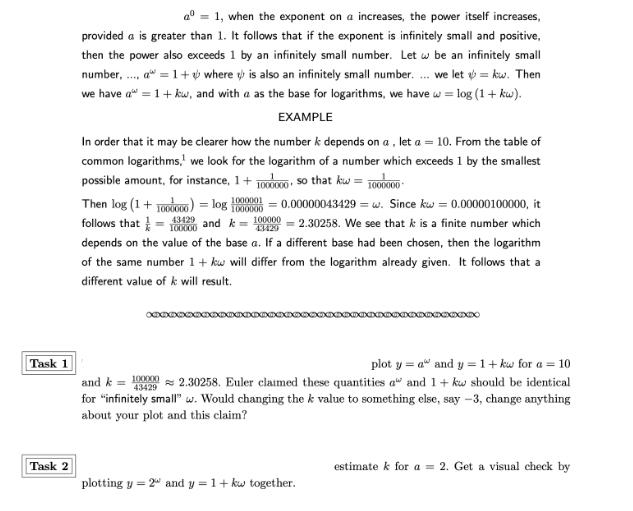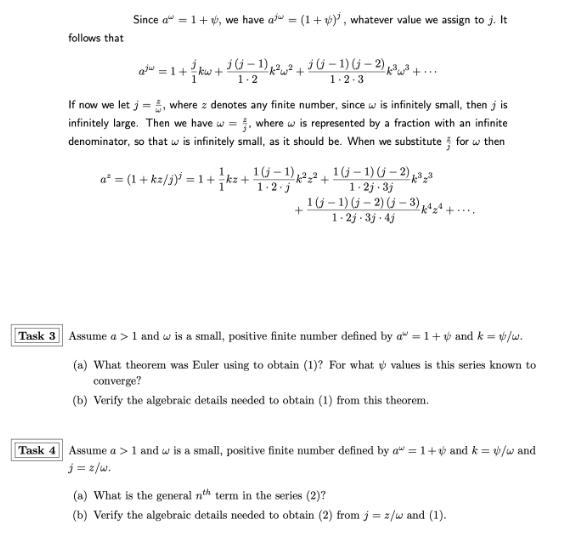Answered step by step
Verified Expert Solution
Question
1 Approved Answer
Task 1 Task 2 a = 1, when the exponent on a increases, the power itself increases, provided a is greater than 1. It


Task 1 Task 2 a = 1, when the exponent on a increases, the power itself increases, provided a is greater than 1. It follows that if the exponent is infinitely small and positive, then the power also exceeds 1 by an infinitely small number. Let w be an infinitely small number, a 1+ where is also an infinitely small number.... we let = kw. Then we have a = 1+kw, and with a as the base for logarithms, we have w = log (1+kw). EXAMPLE In order that it may be clearer how the number k depends on a, let a = 10. From the table of common logarithms, we look for the logarithm of a number which exceeds 1 by the smallest possible amount, for instance, 1+ 1000000 so that ku = 1000000 Then log (1 + 1000000) = log100000 = 0.00000043429= w. Since kw=0.00000100000, it follows that=10000 and k = 10000=2.30258. We see that is a finite number which depends on the value of the base a. If a different base had been chosen, then the logarithm of the same number 1+kw will differ from the logarithm already given. It follows that a different value of k will result. plot ya and y = 1+kw for a = 10 and k = 1000 2.30258. Euler claimed these quantities a" and 1+kw should be identical for "infinitely small" w. Would changing the value to something else, say -3, change anything about your plot and this claim? 43429 plotting y = 2 and y = 1+kw together. estimate k for a= 2. Get a visual check by Since a = 1+, we have a = (1+1), whatever value we assign to j. It follows that + kw 3 + 1 = 10 - 1) 22 - 10 - 1) (6 2) 33 + + 1-2 1-2-3 If now we let j =, where z denotes any finite number, since w is infinitely small, then j is infinitely large. Then we have w, where w is represented by a fraction with an infinite denominator, so that w is infinitely small, as it should be. When we substitute for w then 3 + kz + 165-122 +16-10-2) 3.3 1j10242 1.2.j 1.2j.3j a = (1+kz/j) = 1 +=kz+ + 1(-1) (-2) (-3) 424+.... 1-2; 3j 4j Task 3 Assume a > 1 and w is a small, positive finite number defined by a = 1+ and k = w/w. (a) What theorem was Euler using to obtain (1)? For what values is this series known to converge? (b) Verify the algebraic details needed to obtain (1) from this theorem. Task 4 Assume a > 1 and w is a small, positive finite number defined by a = 1+ and k = w/w and j=z/w. (a) What is the general nth term in the series (2)? (b) Verify the algebraic details needed to obtain (2) from j=z/w and (1).
Step by Step Solution
★★★★★
3.47 Rating (150 Votes )
There are 3 Steps involved in it
Step: 1
Task 1 matlab Plot ya and y 1 komega for a 10 a 10 k 10000043420 omega log1 11000000 loga x linspace...
Get Instant Access to Expert-Tailored Solutions
See step-by-step solutions with expert insights and AI powered tools for academic success
Step: 2

Step: 3

Ace Your Homework with AI
Get the answers you need in no time with our AI-driven, step-by-step assistance
Get Started


